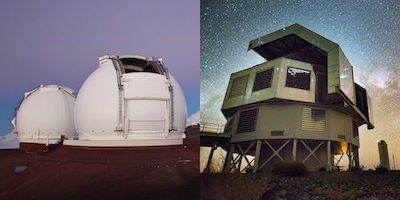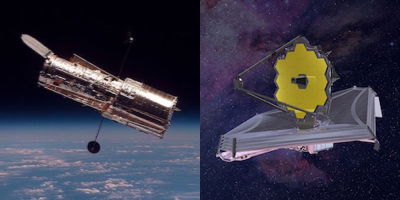Research


Images of Keck and Magellan Telescopes © R. Trainor; Images of HST and JWST © NASA/ESA
You can find all my published work on the NASA ADS or my Google Scholar profile.
I am an observational astronomer, and my students and I study the evolution of galaxies and quasars over cosmic time. I am particularly interested in the evolution of the faintest galaxies in the peak epochs of star formation and black hole accretion (2 < z < 3, 10-12 billion years ago), as well as the interactions between galaxies and supermassive black holes during this time. Most of my work uses optical and infrared images and spectra from the LRIS, MOSFIRE, and KCWI instruments on the 10-m Keck 1 telescope at the W.M. Keck Observatory, as well as data from the Hubble Space Telescope. I was also part of the team that built and commissioned MOSFIRE, and I have recently begun working with radio telescopes such as IRAM/NOEMA.
Understanding Lyman-alpha Emission
Several of my projects focus on understanding a specific type of light called Lyman-alpha (Lya) emission. Lya emission is emitted by excited hydrogen gas, and excited hydrogen tends to sit near newly-formed stars and “active” black holes in galaxies. Using this light is therefore a good way to see where stars and black holes are forming in the Universe.
This Lya light is also complicated, however, because it is scattered by the hydrogen in galaxies as it tries to get out. In one of our recent papers, we conducted a careful analysis of different methods for estimating how many Lya photons were created in galaxies and how many of them escape in order to predict the total efficiency with which these photons are detected in our measurements of galaxies. (see paper)
Properties of “Baby” Galaxies
I am currently studying young galaxies called Lyman-alpha emitters (LAEs). These galaxies have a lot of gas that they are beginning to turn into stars. Using images and spectra from Keck and the Hubble Space Telescope, I am studying the properties of stars in these galaxies and how stellar feedback produces heavy elements within the galaxies as well as driving gas and ultraviolet photons out of the galaxies.
We published a paper showing that these faint, young LAE galaxies are able to produce outflows that drive gas (and heavy elements) out of the galaxies, but that these outflows are much weaker than the outflows produced by brighter, more massive galaxies. These observations show that galaxy feedback works differently at different galaxy mass scales. (see paper)
We also published another paper demonstrating that LAEs have extreme properties that suggest the presence of very pristine gas (without much heavy element contamination) and very hot populations of massive stars. These stars may be produced by the evolution of binary systems, as described by new models of stellar evolution. This work would not have been possible without the new instrument MOSFIRE described below. (see paper)
Gas and Dark Matter Environments of QSOs
Hyperluminous QSOs are extremely bright and exceedingly rare; these objects are brighter than 10^14 solar luminosities, and there are likely only a few dozen of them in the observable universe.
By studying the spatial and velocity distribution of galaxies near the QSOs, we were able to determine that these QSOs sit in dark-matter halos of similar masses to those hosting lower-luminosity AGN and typical star-forming galaxies at these redshifts. In addition, we found that the QSOs are associated with high local densities of galaxies, which suggests that recent galaxy mergers are more important than halo mass in producing efficient (ie. hyperluminous) black-hole accretion. (see paper)
The brighest QSOs produce intense ionizing fields that can exceed the UVB by factors of ~1000x over scales of an Mpc or more. This makes the fields around QSOs excellent places to look for fluorescent emission, where ionizing photons are reprocessed by dense Hydrogen gas and reemitted as Lya photons. Using narrow-band filters tuned to the Lya line at the redshift of the QSOs, we have identified ~1000 Lyman-alpha emitters (LAEs) that may be exhibiting fluorescent emission, and we have obtained ~400 spectra of the Lya lines.
The Lya luminosity function and distribution of Lya equivalent widths (far exceeding those seen in star-forming galaxies in many cases) show strong evidence for fluorescent emission in many of our candidates, and the distribution of these candidates (in redshift and the plane of the sky) implies that the hyperluminous QSOs in our sample have lifetimes between 1 and 20 Myr. (see paper)
Furthermore, our Lya spectra reveal rich properties in their line profiles (multi-peaked emission, red- and blue-dominant peaks, etc.) that may tell us about their kinematics and the effects of radiative transfer. With continuing MOSFIRE observations, we will further probe the physical properties of these objects.
Instrumentation

As a member of the MOSFIRE instrument team, I helped calibrate and commission the instrument, focusing in particular in the modeling of the instrument flexure (as it lies at the Cassegrain focus of the Keck 1 telescope) and calibrating the flexure compensation system.
MOSFIRE is now fully operational and taking beautiful NIR spectra and images (with minimal residual flexure). Check astro-ph or the ADS for recent results!
